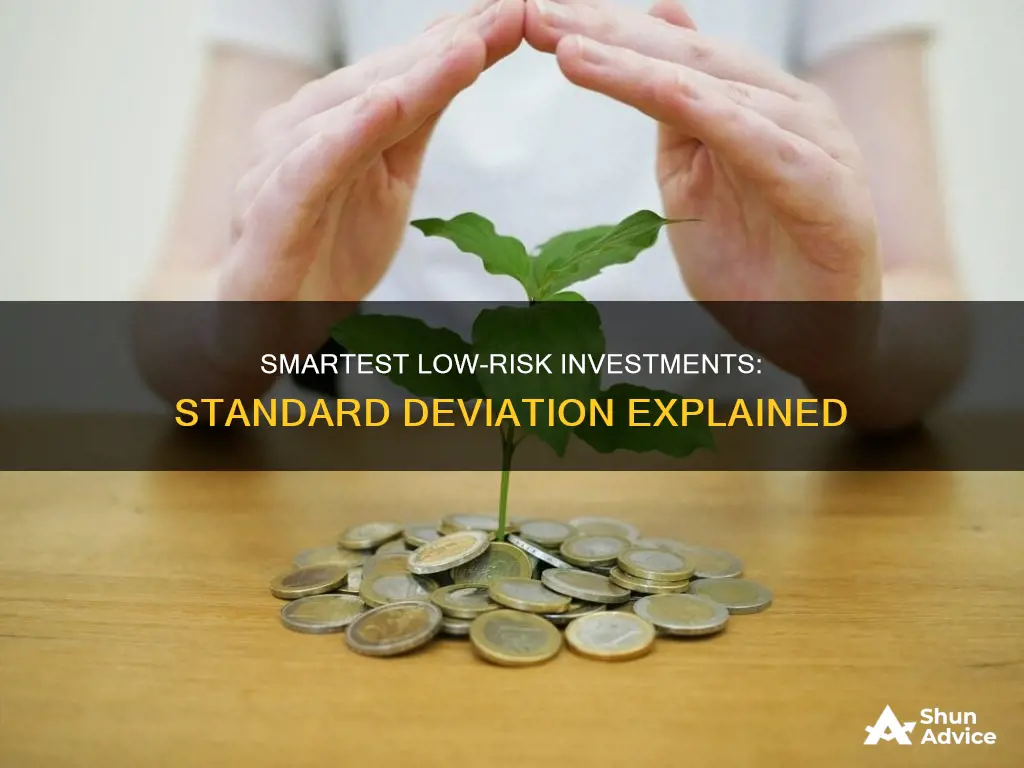
When it comes to investing, there are a number of factors to consider when assessing risk. One of the most important is standard deviation, which measures the volatility of an investment's returns. A high standard deviation means that prices are fluctuating wildly, indicating a risky investment. Conversely, a low standard deviation suggests that prices are more stable, and therefore the investment is less risky. In this article, we will explore which investments offer the least amount of risk in terms of standard deviation and how investors can use this information to make informed decisions.
What You'll Learn

Coefficient of variation
The coefficient of variation is a measure of risk that is calculated by dividing the standard deviation by the expected return and then multiplying by 100 to get the percentage. A lower coefficient of variation indicates a lower-risk investment.
For example, consider two investments with the same expected return. Investment A has a standard deviation of $100, while Investment B has a standard deviation of $200. Investment A has a lower coefficient of variation and is therefore the less risky option.
The coefficient of variation is particularly useful when comparing investments with different expected returns. It allows investors to assess the risk-adjusted return of an investment, helping them make more informed decisions.
However, it's important to note that the coefficient of variation is just one metric among many when evaluating investment risk. Other factors, such as market conditions, investment time horizon, and an investor's risk tolerance, also play a crucial role in determining the overall risk profile of an investment.
In summary, the coefficient of variation is a valuable tool for assessing investment risk. By taking into account both the standard deviation and the expected return, it provides a more nuanced understanding of risk compared to solely relying on standard deviation. Investors can use this metric to make more informed decisions and better manage their investment portfolios.
Funding Medical School: Strategies for Payment and Investment
You may want to see also

Standard deviation and expected return
Standard deviation is a measure of volatility, or how much prices move around. When prices move wildly, the standard deviation is high, meaning an investment is more risky. Conversely, a low standard deviation means prices are more stable, so investments come with less risk. The smaller the standard deviation, the less risky an investment will be, dollar-for-dollar.
To calculate the risk of an investment, you can divide the standard deviation by the expected return and then multiply by 100 to get the percentage. For example, if an investment has a standard deviation of $400 and an expected return of $5,000, the coefficient of variation is 8%. This means that the investment has a relatively low risk.
However, it's important to note that standard deviation only measures risk in terms of price volatility. Other factors, such as the financial health of the company, industry trends, and market conditions, can also affect the riskiness of an investment. As with anything else, the greater the number of possible outcomes, the greater the risk of choosing the wrong one.
India's Superpower Status: American Investment Opportunities
You may want to see also

Volatility
While investors can assume price remains within two standard deviations of the mean 95% of the time, this can still be a very large range. As with anything else, the greater the number of possible outcomes, the greater the risk of choosing the wrong one. The standard deviation is the square root of the variance. By taking the square root, the units involved in the data drop out, effectively standardizing the spread between figures in a data set around its mean.
Opening an Investment Advisory Firm: Navigating India's Market
You may want to see also

Price stability
The standard deviation is a statistical measure that quantifies the dispersion or volatility of a set of data values. In the context of investments, it reflects the extent to which an investment's price deviates from its average or expected value.
A small standard deviation indicates that the investment's price remains relatively close to its average value, implying a lower risk. Conversely, a large standard deviation suggests that the investment's price can deviate significantly from its average, making it more volatile and riskier.
For example, consider two investments with different standard deviations. Investment A has a standard deviation of $50, while Investment B has a standard deviation of $200. If both investments have an average return of 10%, it means that Investment A's actual returns could range from $50 below to $50 above the average, while Investment B's returns would be expected to vary by up to $200. In this case, Investment B offers greater price stability, as its returns are more likely to remain within a narrower range around the average.
Therefore, when assessing investments, a key consideration is their standard deviation, as it provides insight into the level of price stability and the associated risk. Lower standard deviations indicate more stable investments, while higher standard deviations suggest greater volatility and potential risk.
Investing in 5G: Strategies for Profitable Opportunities
You may want to see also

Risk calculation
To calculate the risk of an investment, you can use the coefficient of variation. This is calculated by dividing the standard deviation by the expected return and then multiplying by 100 to get the percentage. The coefficient of variation is a measure of volatility and is used to determine the level of risk of an investment.
For example, if an investment has a standard deviation of $400 and an expected return of $5,000, the coefficient of variation would be 8%. This means that the investment has a relatively low level of risk.
On the other hand, if an investment has a high standard deviation, it means that prices are moving wildly and the investment is more risky. A low standard deviation means that prices are more stable and the investment comes with less risk.
Therefore, when calculating the risk of an investment, it is important to consider both the standard deviation and the expected return. By dividing the standard deviation by the expected return, you can get a percentage that represents the level of risk.
Transferring Your Investment HSA to Savings: A Step-by-Step Guide
You may want to see also
Frequently asked questions
The investment with the lowest standard deviation.
Standard deviation is a measure of volatility. When prices move wildly, the standard deviation is high, meaning an investment is more risky.
The standard deviation is the square root of the variance. By taking the square root, the units involved in the data drop out, effectively standardising the spread between figures in a data set around its mean.
A low standard deviation means prices are more stable, so investments come with less risk.







